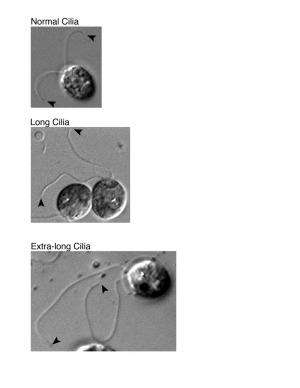Cellular tail length tells disease tale

Simon Fraser University molecular biologist Lynne Quarmby's adventures in pond scum have led her and four student researchers to discover a mutation that can make cilia, the microscopic antennae on our cells, grow too long. When the antennae aren't the right size, the signals captured by them get misinterpreted. The result can be fatal.
In a newly published paper in the science journal Current Biology, the researchers discovered that the regulatory gene CNK2 is present in cilia and controls the length of these hair-like projections.
This discovery is important because cilia, or flagella, dangle from all of our cells. Their ability to propel some cells, such as sperm, and allow molecular communication in others, for example cellular responses to hormones, determines how we develop from embryos and how our bodies function in adulthood.
When cilia are too short or too long they cause various human hereditary diseases and deformities, such as too many fingers or toes, blindness and Polycystic Kidney Disease, which affects one in 600 people.
Quarmby and her doctoral student Laura Hilton—senior and lead authors, respectively, on this paper—are among the few scientists globally who study cilia-disassembly as opposed to -assembly.
A crucial part of all cells' lifecycle is their cilia's disassembly before cell division and assembly after it. The gene LF4 is a known assembly regulator, and, prior to this study, scientists thought that assembly speed controlled cilia's ultimate length or shrinkage. But Quarmby and Hilton have discovered that disassembly speed is also important, and that the regulatory gene CNK2 plays a key role in controlling it.
Similar to how a balance between water pressure and gravity determines the height of a fountain's stream, a balance of assembly and disassembly speed determines cilia's length. When growing and shrinking happen simultaneously cilia length remains constant.
Pond scum's algae make good lab models for analyzing this because they reproduce quickly, and they have cellular structure and cilia that closely parallel ours. Quarmby and Hilton have been mucking about with pond scum for years and recently started studying algae cilia with defective CNK2 and LF4 genes.
After discovering that cilia with either defective gene are abnormally long, they created an algae cell with four cilia, instead of the normal two, with two of the four engineered to glow green.
Along with two SFU undergrad students and a University of Toronto undergrad, Quarmby and Hilton watched as the fluorescent green tag began to appear at the tip of the untagged pair of cilia.
"We were able to deduce how the mutations affected the cilia's assembly and disassembly by measuring how much and how quickly green fluorescence appeared at the tip of the untagged cilia," explains Quarmby.
"We knew that we had something important when we saw that cells bearing mutations in both CNK2 and LF4 had the most extraordinarily long cilia. They were unlike anything anyone had ever seen before.
"My student Laura ran this experiment and oversaw our undergrad researchers. It gave us unique insights into the potentially key role disassembling cilia have in deciding the tails' length. Further investigation will help us understand how ciliary malfunction causes a progression of diseases."
The SFU undergrads working with Quarmby and Hilton were Kavisha Gunawardane and Marianne Schwarz. The UofT student was Joo Wan (James) Kim.
Journal information: Current Biology
Provided by Simon Fraser University

















